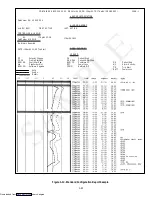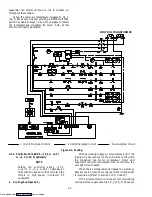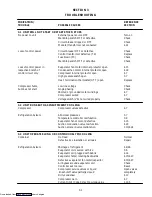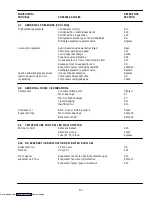
4-1
SECTION 4
SERVICE
NOTE
To avoid damage to the earth’s ozone layer, use a refrigerant recovery system whenever removing refrigerant. When
working with refrigerants you must comply with all local government environmental laws, U.S.A. EPA section 608.
4.1 MANIFOLD GAUGE SET
The manifold gauge set can be used to determine system
operating pressure, add a refrigerant charge, equalize or
evacuate the system.
The manifold gauge in Figure 4-1 shows hand valves,
gauges and refrigerant openings. When the low pressure
hand valve is frontseated (turned all the way in), the low
(evaporator) pressure can be checked. When the high
pressure hand valve is frontseated, high (condensing)
pressure can be checked.
W
hen both valves are open
(turning counter clockwise), high pressure vapor will flow
into the low side. When the low pressure valve is open, the
system can be charged. Oil can also be added to the system.
Only a R-134a manifold gauge set with self-sealing
hoses as shown in Figure 4-2 (CTD P/N 07-00294-00, which
includes items 1 through 6) can be used when working on
the models covered within this manual.
Opened
(Backseated Hand Valve )
Closed
(Frontseated Hand Valve)
Low Pressure Gauge
High Pressure Gauge
A
B
C
A. Connection to Low Side of System
B. Connection to High Side of System
C. Connection to Either:
Refrigerant Cylinder or
Oil Container
Figure 4-1. Manifold Gauge Set
a. Connecting the Manifold Gauge Set (See Figure 4-2)
1. Remove service valve stem caps and check both
service valves to make sure they are backseated (counter
clockwise). Remove service port caps.
NOTE
If a manifold gauge set is new or was exposed to the
atmosphere. Due to repair, it will need to be
evacuated to remove contaminants and air as follows:
a. Midseat both hand valves.
b. Connect the utility hose (yellow) to a vacuum
pump.
c. Evacuate to 10 inches of vacuum.
d. Charge with R-134a to a slightly positive pressure
of 0.1 kg/cm
@
(1.0 psig).
e. The gauge set is now ready for use.
2. Connect the high side field service coupling
(backseated) to the discharge service valve port (or the
manual liquid line valve port, whichever is applicable).
3. Turn the high side field service coupling (red knob)
clockwise, which will open the high side of the system to the
gauge set.
4. Connect the low side field service coupling to the
suction service valve port.
5. Turn the low side field service coupling (blue
knob), which will open the low side of the system to the
gauge set.
6. To read system pressures; slightly midseat the
discharge and suction service valves, and frontseat both
manifold gauge set hand valves.
CAUTION
To prevent trapping liquid refrigerant in the service
valve after charging, while the compressor is ON and
before disconnecting the manifold gauge set, perform
the following steps:
a. Backseat applicable discharge or manual liquid
line valve.
b. Midseat manifold gauge set hand valves.
c. Allow the gauge set to pull down to suction pressure.
b. Removing the Manifold Gauge Set
1. While the compressor is still ON, backseat the
discharge service valve.
2. Midseat both hand valves on the manifold gauge
set and allow the pressure in the manifold gauge set to be
drawn down to suction pressure. This enables the liquid that
condensed in the high side hose to be returned to the
system.
3. Backseat the suction service valve. Backseat both
field service couplings, and remove the couplings from the
service ports.
4. Install both service valve stem caps and service
port caps (finger-tight only).
Downloaded from
















































